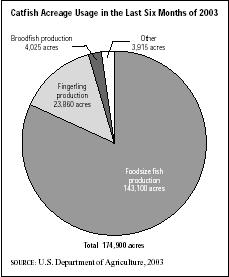SIC 0273
ANIMAL AQUACULTURE
This industry classification includes establishments engaged in the production of finfish and shellfish within a confined space and under controlled growing and harvesting procedures. It includes farmed aquatic animals intended as human food (catfish, trout, and oysters), bait (minnows), and pets (goldfish and tropical aquarium fish). Establishments primarily engaged in hatching fish and in operating fishing preserves are classified in SIC 0921: Fish Hatcheries and Preserves.
NAICS Code(s)
112511 (Finfish Farming and Fish Hatcheries)
112512 (Shellfish Farming)
112519 (Other Animal Aquaculture)
The aquaculture industry entered the 2000s with significant economic promise. Production was small but growing. Aquaculture crops had doubled between 1975 and 1983, and although the U.S. aquaculture industry met with relatively flat growth in the per capita consumption of seafood throughout the 1990s, both domestic production and imports were expected to increase in the early 2000s, due in part to increasing good news about the health benefits of seafood. Of total seafood consumed, shrimp, salmon, tuna, and catfish accounted for the largest segment of the aquaculture industry in 2003, according to the U.S. Department of Agriculture (USDA). The USDA predicts that competition from the growing pork and poultry industries will pose greater challenges throughout the twenty-first century.
Despite somewhat slow growth, consumption of farm-raised seafood was on the rise. According to the United Nations's Food and Agriculture Organization, aquaculture production had more than doubled between 1990 and 2000, producing aquatic animals and plants worth more than $42 billion. Sales of catfish from growers to processors were predicted to reach between $470 and $480 million in 2003. These figures represent substantial growth over 1985 statistics, when aquaculture posted U.S. farm receipts valued at only $205 million. Seafood industry analysts expect aqua-culture to play an ever-increasing role in providing fisheries products to the marketplace.
The aquaculture industry is not, however, limited to seafood production. Ornamental fish exports increased in the early 2000s, particularly to Asia, despite recessions and financial crises. During the first half of 2003, U.S. ornamental fish exports rose to $4.4 million. The largest export market for ornamental fish is Hong Kong. The value of ornamental fish imports remained steady at $43 million in 2003.

Although aquaculture is a relative newcomer to U.S. economic importance, the industry itself is not new and has applications in many parts of the world. The Japanese have raised oysters for centuries; the ancient Romans also raised oysters. Many Pacific island nations have turned swampy seaside areas into simple fish farms.
During the 1860s, the United States developed techniques for raising salmon and trout in captivity. By 1990, nearly all catfish, rainbow trout, and hybrid striped bass consumed in U.S. restaurants were harvested from fish farms.
Catfish. Sales of catfish remained strong in the early 2000s, with 2003 sales from growers to processors reaching 650 million pounds. This marked a 3 percent increase over 2002 sales. Production remained strong due to stable prices and lower feed costs. The leading catfish producing states include Alabama, Arkansas, Mississippi, and Louisiana, which together account for more than 90 percent of total catfish production. Due to low prices, catfish growers began to reduce their acres of ponds in use in 2003. Catfish farmers used 174,900 acres of ponds in the last half of 2003, compared to 173,900 acres during the same period in the previous year. Of these acres, 143,100 acres were devoted to foodsize catfish production, while 23,860 were used for fingerlings (feeding), and 4,025 for broodfish (breeding) production.
Shrimp. Shrimp is one of the most highly regarded crops. It is the most popular seafood product in the United States and boasts the highest consumption.
Shrimp are especially suitable for farming because of their high market value, rapid growth, and low position on the food chain. Successful shrimp culturing operations are already underway in Ecuador, Thailand, and China, and aquaculturists predict their growth in the United States. However, the U.S. continued to rely heavily on shrimp imports, when grew 41 percent between 1998 and 2003. In fact, in 2003, shrimp imports, which exceeded 1 billion pounds, were worth an estimated $3.3 billion. Thailand is the largest shrimp importer to the United States, accounting for $393 million in shipments during the first half of 2003 alone.
Tilapia. Production of tilapia in the United States continued to increase in the late 1990s and 2000s, with the north central region dominating tilapia production. Production is expected to expand in the north central and southern regions as well. If live product continues to generate greater demand than processed product, long-term prospects are not exceedingly optimistic for domestic growers. The U.S. Department of Agriculture, however, expects the larger long-term market demand to be for processed products. Between 1998 and 2003, tilapia imports soared 230 percent to 100 million pounds.
Mussels, Clams, and Oysters. Exports of clams and oysters declined slightly in the late 1990s but rebounded in the early 2000s, despite slower than expected economic recovery in Asian economies. In the first half of 2003, exports of mussels, clams, and oysters jumped 19 percent to 5 million pounds. Oysters saw the most significant growth, accounting for nearly half of total exports. According to the USDA, increasing mollusk prices coupled with continued weakness in Asian economics will curb demand for mollusk exports in 2004 and 2005. Imports of clams grew 27 percent to 4.4 million pounds in the first six months of 2003, while imports of oysters grew 31 percent to 9.6 million pounds. Mussel imports, however, declined 16 percent to 24.2 million pounds during this time period.
Further Reading
U.S. Department of Agriculture. "Aquaculture Outlook." Washington, DC: Economic Research Service, 9 October 2003. Available from http://usda.mannlib.cornell.edu/reports .
Comment about this article, ask questions, or add new information about this topic: